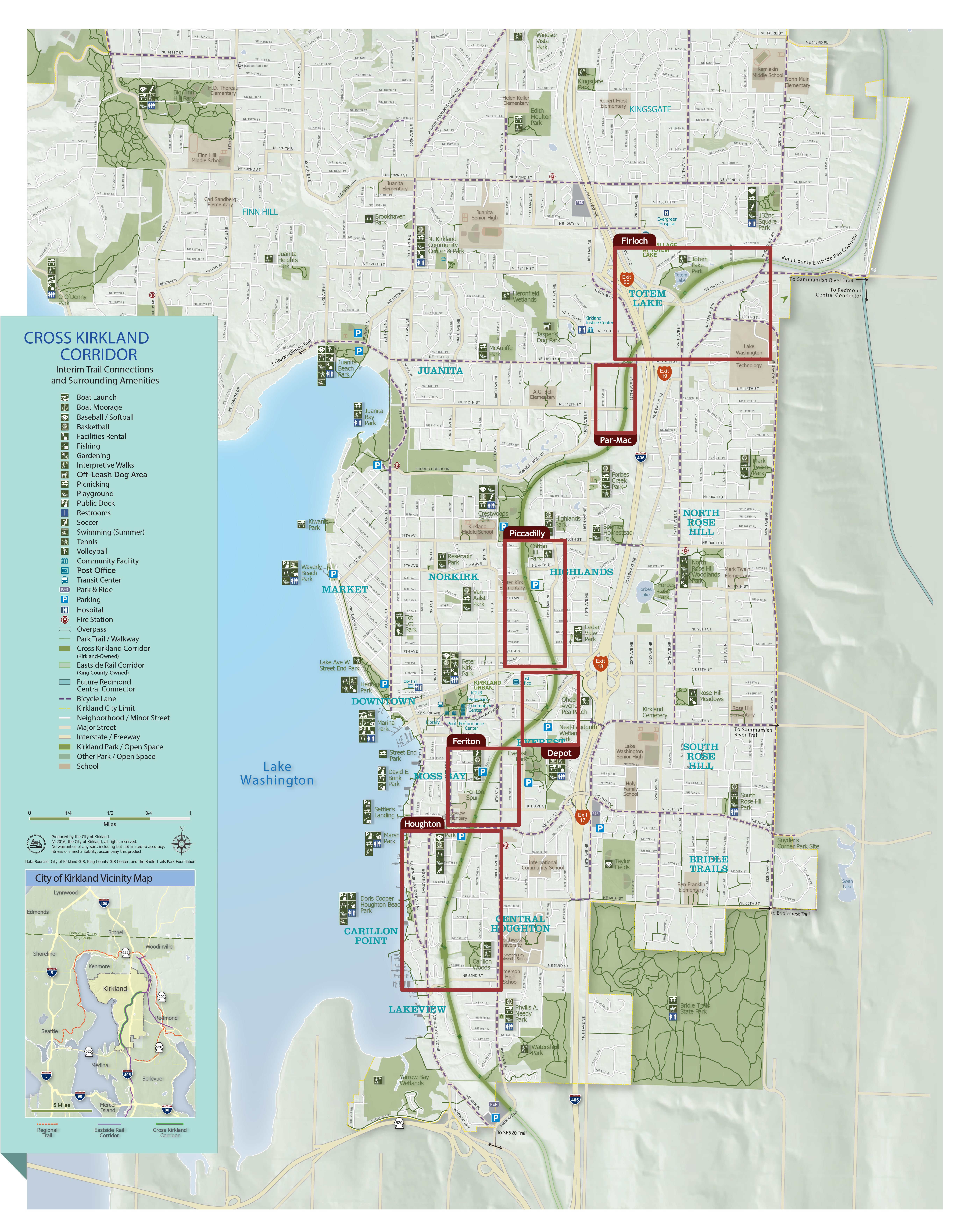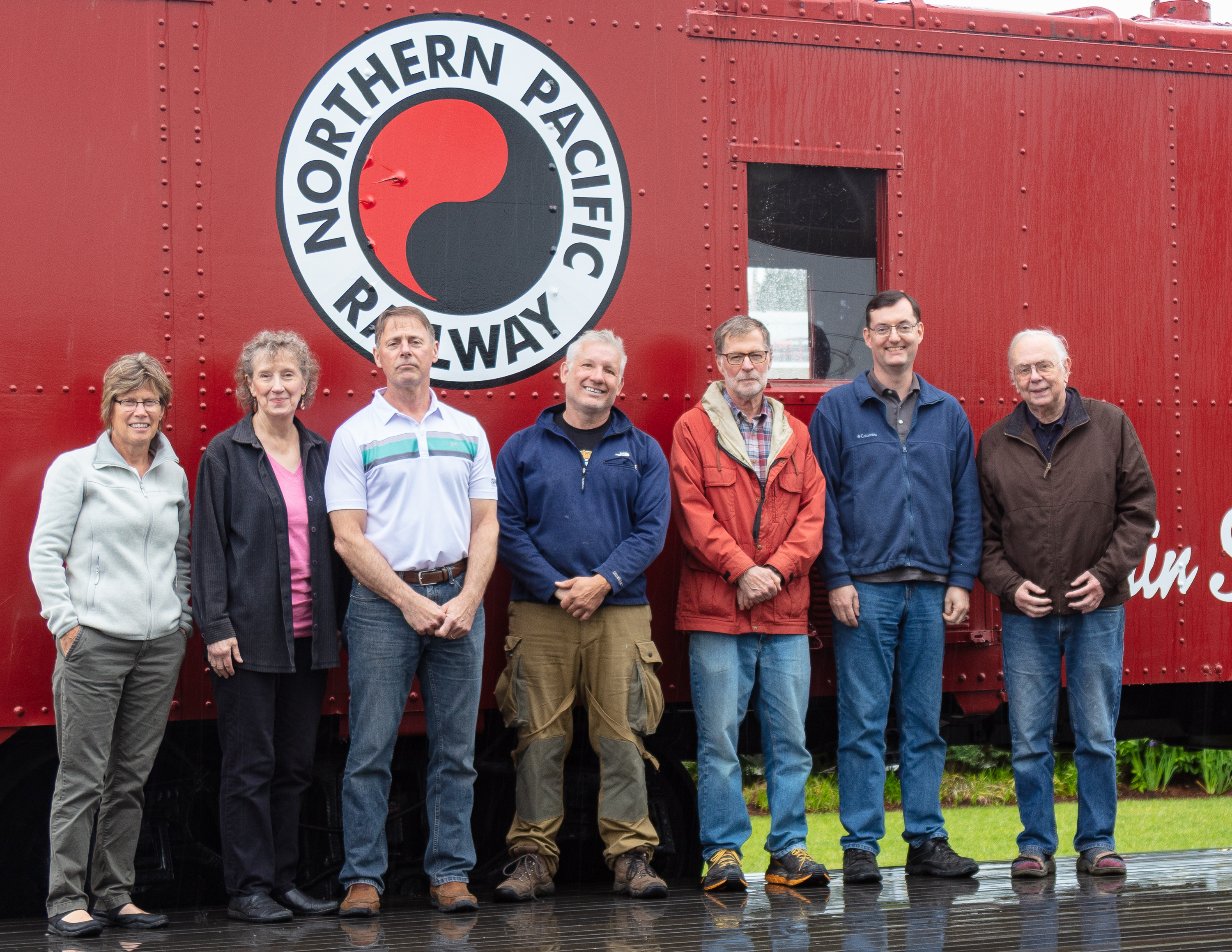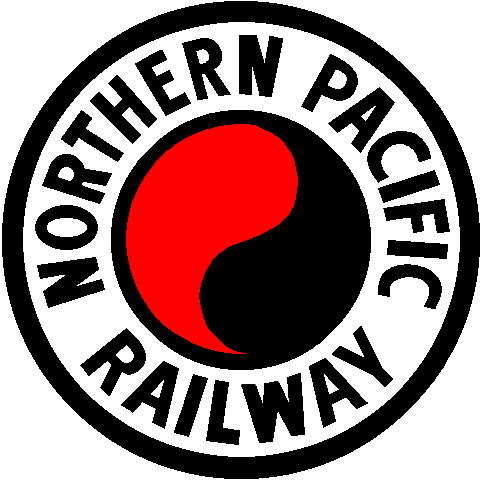The Railroad and the Industries It Served, 1905-2009
By Kent Sullivan and Matt McCauley
Introduction
The Cross-Kirkland Corridor (CKC) is a popular multi-use recreational trail. It is common knowledge that it is a former rail grade, but most Kirklanders are unaware of its fascinating history. The nearly six-mile-long stretch of the former railroad that it occupies was opened in 1905 as part of the Lake Washington Belt Line (LWBL) of the Northern Pacific Railway.
The CKC crosses or adjoins eight neighborhoods, four major business districts, more than a dozen parks, and several public schools. The LWBL clearly has a future as the CKC, one that will continue to be the subject of much interest and discussion by the people of Kirkland and King County.
This content focuses on both general information about the LWBL and the six areas along today’s CKC containing historic points of interest. It is intended to provide a general overview for people interested in the CKC, from those in government or industry to the casual walker or bike rider, with deeper links for those who want to learn more.

Explore the history of the Lake Washington Belt Line!
History and context of the LWBL
Feriton, aka the “Railroad Yard”
Depot Area, i.e. the area around the 1912 NP depot
Piccadilly Area, i.e. the area near the intersection of the LWBL and Kirkland’s 7th Avenue, originally named Piccadilly Avenue
Par-Mac Industrial Park, along the CKC, immediately south of NE 116th Street
Firloch, a station near today’s Totem Lake, along the CKC at 124th Avenue NE and NE 124th Street
Derailments, collisions, and safety improvements
Recent LWBL history (need help to create!)
The primary sources of information that informed this work stop in the mid-1970’s. If you can help tell the history from 1975 – 2009, please contact us!
Glossary of Railroad Terms
Depot — A building at a station used to conduct railroad freight, express, and / or passenger business.
Flag Stop — A station where a passenger train is not obliged to stop unless there is a passenger to get on or let off. In some eras the railroad provided a physical flag (or lantern, esp. at night) for a customer to display for the engineer to see so they would know to stop the train.
Passing Track — A specific designation or use of a siding whereby two trains can pass by one “pulling over” into the siding.
Platform — A horizontal structure at ground level that provides a specific location for freight and passenger trains to be loaded and unloaded. Passenger flag stops often had simple platforms, and occasionally an open shed, for inclement weather protection.
Requisition for Authority for Expenditure (RFA) and Authorization for Expenditure (AFE) — Two processes (with forms) for capital expenditures on the railroad. RFA comes first, then AFE.
Siding — An additional track found to the right or left of the main track that allows entry and exit from two directions. One can think of a siding as a double-ended spur.
Spur — A (usually) short stretch of dead-end track branching from the main track that is normally used to serve either customers or to store equipment.
Station — A named place on the railroad. The name is indicated by a physical sign and is also reflected in official documents such as employee time tables and maps. Other physical structures, such as depots and platforms, are separate and optional.
Team Track — A spur or siding for shared use by a group of customers rather than one specific customer. The term originated with teams of horses that once pulled wagons to pick up and deliver freight.
Sources
The research forming the foundation of this website would not have been possible without the following sources. (Acronyms were used in this website’s content and in the filenames of linked reference documents. Those acronyms for are indicated in parentheses below.)
- Burlington Northern Railroad (BN) [now BNSF] – available from NPRHA and BNRHS in various forms.
- East Side Journal (ESJ) newspaper – on microfilm at the Bellevue Main Library of KCLS and on paper at the Kirkland Heritage Society.
- East Side News (ESN) newspaper – on paper at the Kirkland Heritage Society.
- Kirkland Independent (KI) newspaper – on paper at the Kirkland Heritage Society.
- Northern Pacific Railroad / Railway (NP) files – available from NPRHA and Minnesota Historical Society in various forms.
- Oregonian newspaper – Sunday issues online at University of Oregon Library.
- Seattle Post-Intelligencer newspaper – a few clippings found in NPRHA files.
- Seattle Times newspaper – online via Newsbank; access free with Seattle Public Library card.
- The Northwest (magazine produced by the NP); scans available from NPRHA.
Repositories
The various sources of historical research are collected, preserved, and indexed by many dedicated employees and volunteers who staff repositories around the PNW. Please support these organizations with your time and financial contributions as you are able!
Bellevue Main Library in the King County Library System (KCLS) in Bellevue, WA
King County Road Services (KCRS) Map Vault on the Internet
Kirkland Heritage Society (KHS) in Kirkland, WA
Map Library at the University of Washington (UWML)
Museum of History and Industry (MOHAI) Research Library in Seattle, WA
National Archives (NARA) in Seattle, WA
Northern Pacific Railway Historical Association (NPRHA) website
NPRHA files at the Jackson Street Roundhouse (JSRH), operated by the Minnesota Transportation Museum, in St. Paul, MN
NPRHA files at the Pacific Northwest Railroad Archive (PNRA) in Burien, WA
Puget Sound Regional Branch (PSRB) of the Washington State Archives (WSA), in Bellevue, WA
Newsbank service via The Seattle Public Library
Acknowledgments
Jack Christensen is a retired NP / BN / BNSF locomotive engineer and artist. He generously shared his memories of running trains through and around Kirkland. He lives in Edmonds, WA.
Dan Cozine is a PNW railroad historian. He generously shared his years of research and deep knowledge of NP maps and time tables. He lives in Bothell, WA.
Eugene Deimling is a skilled Proto48-scale modeler whose layout includes the Kirkland area. He generously shared his research and a photo of an NP automobile box car. He lives in El Dorado Hills, CA.
Carl Johnson is a retired Maintenance Supervisor for the BNSF and a NP / GN railfan. His father Russell Johnson was a NP locomotive engineer and railfan. Carl generously contributed some of his father’s photographs. Carl lives in Acme, WA.
Doug Leach and Rick Leach are a father-and-son photographer powerhouse for the NP and BN, especially on the branch lines east and north of Seattle. They generously contributed their memories of railroad operations and photographs. Doug lives in Bothell, WA and Rick lives in Moyle Springs, ID.
Daniel Leen is an author and former semi-professional hobo. He generously contributed some of his photograph. Daniel lives in Seattle, WA.
John Magnuson is a railfan and has fond memories of the NP in Kirkland while growing up in the 1950s and author of an article about them in the Summer, 1993 NPRHA Mainstreeter. He generously contributed some of his photographs and memories. John lives in Roro, Sweden.
Allen Miller is a railroad historian, especially of the Milwaukee Road in western Washington but also of the NP. He generously contributed some of the photographs he has collected. Allen lives in Darrington, WA.
Gary Muehlius is a dedicated NP railfan. He generously shared some of his photographs. Gary lives in Renton, WA.
Midori Ozaki is an Archivist and Phil Stairs is a Research Assistant at the Puget Sound Regional Branch of the Washington State Archives, in Bellevue, WA. Their expert help advice were essential to uncovering photos of Kirkland businesses in the historic King County property tax records held by the Archives.
Dave Sprau is a retired NP / BN dispatcher and railroad historian. He generously shared his deep knowledge of NP operations and many items from his research files. He lives in Warren, OR.
Alan Stein is a Seattle-area historian and one of the creators of History Link. His countless hours of work to create an index of the East Side Journal newspaper was a centerpiece of this project. Without it, there would be no website! He lives in Edmonds, WA.
The CKC History Group
The CKC History Group is an informal team of people interested in the history of the Cross-Kirkland Corridor. Its members, as of January 2019, are: Dave Aubry, Loita Hawkinson, Dawn Laurant, Ellen Miller-Wolfe, Matt McCauley, Sally Otten, Kari Page, Kent Sullivan, Dave Tomson, and Don Winters.
Matt McCauley and Kent Sullivan are the primary authors of the content for the Lake Washington Belt Line feature.

Members of the CKC History Committee, May, 2019: (left to right) Kari Page, Loita Hawkinson, Dave Tomson, Matt McCauley, Don Winters, Kent Sullivan, and Frank Rosin. Not pictured: Dave Aubry, Dawn Laurant, and Ellen Miller-Wolfe

